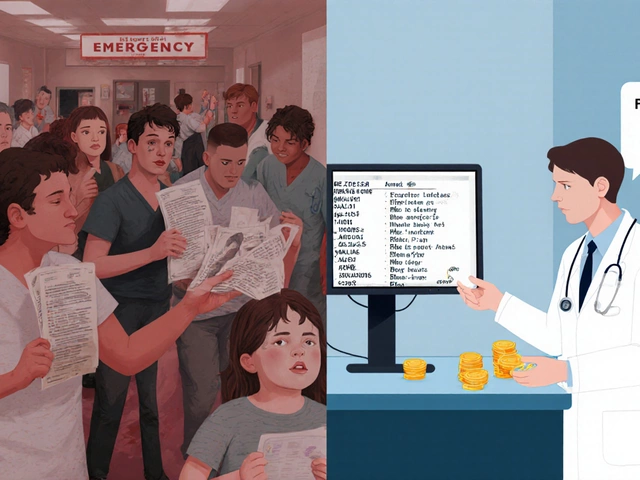Ever wondered if a US hospital could actually turn you away? It's not a simple yes or no. In the land of private healthcare, things can get a bit murky. Here's the deal: there's a key piece of legislation called the Emergency Medical Treatment and Labor Act (EMTALA). This law is like a safety net for patients—it requires hospitals to provide emergency medical treatment to anyone needing it, regardless of insurance status or ability to pay. Sounds reassuring, right? But hang on, there’s more to the story.
Once you step into a hospital seeking emergency treatment, laws are on your side. But if it’s not an emergency, things can change. Private hospitals often have different rules than public ones, especially concerning non-emergency cases. This can sometimes lead to confusion and, let's face it, stress. Financial concerns play a big part too—if you can't guarantee payment, does that mean you'll be shown the door? Not always, but knowing your rights and what steps to take makes all the difference.
- Introduction to Patient Rights
- The Role of EMTALA
- Private Hospitals vs. Public Expectations
- Financial and Insurance Considerations
- Ethical Dilemmas in Patient Care
- Steps to Take if Denied Treatment
Introduction to Patient Rights
Understanding your rights as a patient is like having a compass in the complex world of private healthcare in the US. It's crucial to know what you're entitled to, especially when you find yourself needing medical attention. One of the bedrocks of patient rights is the EMTALA, which ensures that any person, whether in a life-threatening situation or about to give birth, must be attended to in emergencies without being turned away.
But patient rights don't stop at emergencies. In general, you have the right to access your medical records, the right to well-informed consent before any procedure, and even the right to refuse treatment. It's important to understand these rights because navigating hospital visits involves more than just showing up and hoping for the best.
The Hospital Process: What to Expect
When you enter a hospital, there's typically an evaluation or triage process. This is where decisions are made about the urgency of your medical need. In emergencies, thanks to EMTALA, hospitals must stabilize patients before discussing transfer or discharge. For non-emergency situations, hospitals might operate differently, especially those in the private sector.
Insurance and Financial Considerations
Another layer to patient rights involves insurance. In the US, your healthcare experience can vary dramatically based on whether you have insurance and, if so, what kind. While hospitals can't turn away patients in emergencies, they might seek assurance of payment for non-emergency care, which can sometimes feel like walking a tightrope.
| Aspect | Right |
|---|---|
| Emergency Care | Access without discrimination or delay |
| Medical Records | Right to access and obtain copies |
| Consent | Right to give or refuse consent |
| Insurance | Right to know what services are covered |
Everyone deserves to know what's happening with their health, and understanding your rights can make the experience far less daunting. It's about empowering yourself with the information that can guide you, ensuring your hospital visits are what they should be—focused on getting you better, not leaving you guessing.
The Role of EMTALA
So what's the deal with EMTALA? Signed into law back in 1986, this act is a game-changer for anyone worried about being denied treatment in a US hospital. Here's the scoop: EMTALA requires that any patient who shows up in a hospital emergency department must be given a medical screening and, if needed, be stabilized before any talk of transfer or discharge even enters the chat. This is where your patient rights really get some teeth.
But wait, let's dig into the nitty-gritty. A hospital can't just refuse to treat you in an emergency. They can't transfer or discharge you without making sure you're stable either. These rules apply to hospitals that take Medicare payments, which is most of them. So even the fanciest private hospitals have to fall in line.
What Qualifies as an Emergency?
Not every sneeze or scrape counts as an emergency, right? So what does? EMTALA covers anything with the potential to seriously jeopardize your health. Think intense pain, impaired bodily functions, or serious disability risk. And yes, labor falls into this category too. If you're wondering whether your situation fits, it's often up to the healthcare providers to do a medical check to assess it.
Real-Life Impact
To give you an idea of how EMTALA plays out, let's look at some statistics. In a typical year, around 130 million people visit emergency departments across the US. Here's a quick look at how EMTALA affects these scenarios:
| Action | Average Percentage of Emergency Visits |
|---|---|
| Admitted for Further Treatment | 11% |
| Stabilized and Discharged | 83% |
| Transferred to Another Facility | 6% |
Clearly, having laws like EMTALA in place makes a real difference in how emergencies are handled. But remember, once a patient is no longer in an emergency state, hospitals have more freedom to decide the next steps if no financial arrangements can be made.
Private Hospitals vs. Public Expectations
When it comes to private healthcare in the United States, there can be a gap between what people expect and what they really get. Many people think that once they enter a hospital, they'll get treated no matter what. But with private hospitals, that's not always the case unless it's an emergency.
Private hospitals often operate like a business. They balance patient care with financial sustainability, which can sometimes skew their willingness to treat non-emergency cases if insurance details aren’t sorted out. As the American Hospital Association says,
"Balancing the mission of healthcare with business viability is a tightrope walk for private facilities."
What Makes Private Hospitals Different?
Different hospitals have different priorities. Public hospitals are generally funded by the government and may have more leeway to treat patients without getting all the bills sorted immediately. Private hospitals, on the other hand, may scrutinize your insurance details right away to determine how or if they can treat you.
So why does this matter? It can be super important in understanding why you might need to secure good insurance coverage or know about charity care options at facilities in your area.
Expectations vs. Reality
Many expect a hospital visit to be like ordering a meal—get what you need, sort out payment later. But private hospitals are more like buying a new car. You might see what’s offered, but they’ll ask about your financial situation before handing over the keys.
The reality is that while US hospitals are bound by laws like EMTALA to treat emergencies, beyond that, financial considerations come into play, leaving some patients frustrated or confused.

Financial and Insurance Considerations
Money can be a roadblock when it comes to healthcare in the US, especially within the private healthcare system. The reality is, hospitals look at your ability to pay for services. But how exactly does this affect whether you get treated?
Let's start with insurance. If you’ve got health insurance, the type and extent of that coverage can heavily influence the care you receive. Some insurance plans have agreements with certain hospital networks, which means your out-of-pocket costs vary significantly based on where you go. Without insurance, hospitals can bill you directly, often leading to hefty bills. While hospitals can't deny you emergency care due to inability to pay, non-emergency services are where things get trickier.
Uninsured Patients
If you're one of the millions in the US without insurance, you might worry about getting hit with a massive bill. Some hospitals offer sliding scale payment plans or financial assistance. It's worth checking if that’s available where you're seeking care.
Insurance Networks
Ever heard of 'in-network' and 'out-of-network'? These terms decide how much you’ll pay from your own pocket. In-network hospitals have agreements with insurers for negotiated rates, translating to lower personal expenses. Out-of-network services could mean shelling out a lot more.
Costs and Charges
| Service Type | Average Cost Without Insurance |
|---|---|
| Emergency Room Visit | $1,389 |
| Hospital Stay (per day) | $5,220 |
This gives you an idea of what you might face cost-wise. Many hospitals provide upfront cost estimates for procedures, which can help manage your budget.
It's all about planning, knowing your insurance details, and asking about financial aid options. Don’t hesitate to speak with the hospital's billing department—understanding your financial obligations can make a big difference.
Ethical Dilemmas in Patient Care
When it comes to the US healthcare system, ethics play a huge role in how hospitals handle patients. While legally hospitals can't turn away someone in an emergency, the waters get murky when it comes to non-emergency situations. Medical professionals often face tough choices balancing medical policies, patient rights, and financial realities.
One of the stickiest issues is who gets prioritized for treatments. For instance, consider scarce treatment resources or transplant lists, where hospitals must make tough calls. Should priority be given to those who can pay, or should treatments be purely need-based? This is where ethical committees in hospitals step in to guide these tough decisions.
Balancing Costs and Care
Ethical dilemmas also crop up in situations where a patient can't afford their treatment. Many private healthcare providers struggle with offering price concessions while maintaining profitability. Some hospitals use a sliding scale for charges, but it's not the norm. The question often becomes: how do you equity and access for all?
Doctor-Patient Relationships
Doctors often face ethical dilemmas in maintaining transparency with patients, especially when delivering bad news. They have to balance honesty with empathy while considering the patient's cultural and personal needs. It's a delicate dance that can impact trust and overall care quality.
| Scenario | Common Ethical Issues |
|---|---|
| Emergency Care | Who pays for uninsured patients? |
| Transplants | Who gets prioritized for organs? |
| Non-Emergency Services | How to strike a balance between costs and care? |
Ultimately, many of these ethical issues stem from the tension between the business side of hospitals and their care mission. It's crucial that they strive to put patient interests first while also keeping the lights on. For anyone on the receiving end of care, being aware of these dilemmas can help in advocating for yourself effectively.
Steps to Take if Denied Treatment
So, you've found yourself in a nerve-wracking spot where a hospital won’t treat you. First, take a deep breath. Staying calm is your best bet to think clearly and act effectively.
Clarify the Situation
Before assuming the worst, ask the hospital to clarify why treatment is being denied. It might be a simple misunderstanding or a paperwork issue. Clearly understanding the reason gives you a better position to address it.
Request to Speak with a Supervisor
If the initial response leaves you puzzled, request a chat with a hospital supervisor or patient advocate. They're there to help resolve sticky situations like these and can often provide solutions or alternatives you hadn’t considered.
Know Your Rights
Refer to the Emergency Medical Treatment and Labor Act (EMTALA). Hospitals covered by Medicare have to offer emergency care, regardless of your insurance status or ability to pay. If you're dealing with an emergency, remind the hospital staff of this obligation.
Financial Options
Lack of insurance or inability to pay on the spot can lead to denial of non-emergency treatment. But don’t panic yet. Ask about financial assistance programs or payment plans the hospital might offer. Many hospitals can work out a solution.
Seek Legal Help
If everything fails and you still believe your rights are being violated, it might be time to look for legal help. Legal aid organizations or an attorney can guide you on the next steps, especially in cases where EMTALA protections apply.
Contact Local Health Authorities
Reach out to local health departments or state health agencies. They can be surprisingly helpful in pushing hospitals to adhere to their legal obligations.
Look for Alternative Care
If all else fails, consider seeking immediate care from another US hospital or clinic. They might provide the necessary treatment, even if it's a temporary fix.
Remember, understanding and asserting your rights in the complex world of US private healthcare can make a real difference. Being informed equips you to navigate these challenging situations more effectively.





